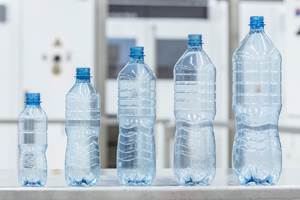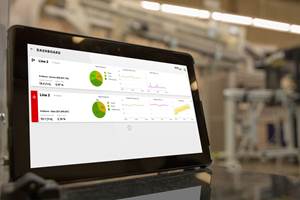Prospects Brighten for PET Beer Bottles
Three hundred billion beer bottles a year worldwide is a mighty tempting target for the plastics industry. So it’s no surprise that 13 of 24 papers focused on beer packaging at the recent Nova-Pack Europe ’99 Conference, held in Germany by Schotland Business Research, Skillman, N.J.
High Hopes for Beer Bottles
Enliven Packaging Conferences
Three hundred billion beer bottles a year worldwide is a mighty tempting target for the plastics industry. So it’s no surprise that 13 of 24 papers focused on beer packaging at the recent Nova-Pack Europe ’99 Conference, held in Germany by Schotland Business Research, Skillman, N.J. Among the highlights were the first published comparison of manufacturing costs for multi-layer and barrier-coated PET beer bottles, an update on nanocomposite barrier materials, and a report on “super-heat-set” PET bottles.
More new developments for beer bottles will be presented at Schotland’s Nova-Pack Americas 2000 conference in Orlando, Fla., at the end of this month. The meeting will hear about two new plasma-coating technologies for PET bottles and a preform overmolding process.
New barriers & coatings
Brewers generally say they need a bottle that provides shelf life of over 120 days with less than 15% loss of CO2 and admittance of no more than 1 ppm of oxygen. Internal or external coatings, and three- or five-layer PET structures using barrier materials are being evaluated to reach that performance.
The upcoming Nova-Pack Americas conference will hear about a “glass” barrier-coating method and an “injection overlay” technology, both developed by Tetra Pak Plastic Packaging Div. in Geneva, Switzerland, whose U.S. office is in Schaumburg, Ill. Bottles made with both techniques are said to be fully recyclable, although full-scale tests are still under way. Commercial release of the technologies will begin in this first quarter.
The first process, called Glaskin, coats the inner surface of a PET bottle with a very thin, clear layer of silicon oxide using a vacuum-deposition process. The “glass” coating reportedly can be applied at rates from 6000 to 18,000 bottles/hr. It is designed for beer, juice, and carbonated soft drinks. The coating is said to extend the shelf life of a PET bottle from four to 12 months. The silica barrier reportedly also provides excellent flavor retention.
Sealica is Tetra Pak’s patented process for molding a multi-layer PET preform using a brand-new thermoplastic epoxy barrier resin called Blox from Dow Plastics, Midland, Mich. Special equipment is used to injection mold the PET preform and then overmold it with the Blox material. This overlay process allows the thickness of the barrier to be varied as needed.
Another new process that applies silicon oxide to the outside of a PET bottle was developed by Atlanta-based Coca Cola Co. with the University of Essen, Germany. It employs vacuum-coating technology from Leybold Systems and a bottle-handling system from Krones, both in Germany. (Leybold Technologies is in Enfield, Conn., and Krones Inc. is in Franklin, Wis.).
The Barrier Enhanced Silica Treated PET (BESTPET) process reportedly gives beer a six-month shelf life. The coating process can be installed between the blowing and filling systems and can coat 0.5-liter bottles at up to 20,000/hr. The coating is also said to be 100% recyclable. A 3000-bottle/hr prototype is installed at Leybold in Germany. The first commercial unit will operate this year in a Coca-Cola bottling plant. Leybold and Krones will offer the process to other firms.
News in nanocomposites
Nanometer-sized clay platelets dispersed in a resin matrix is a new barrier concept for PET bottles. Besides gas barrier, nanoclays reportedly impart higher strength, stiffness, dimensional stability, and heat resistance to a monolayer PET structure, says Chris Matayabas, project manager at Eastman Chemical Co., Kingsport, Tenn.
When the nanometer-thick plates, which have aspect ratios above 200:1, are delaminated and stacked like sheets in a polymer matrix, they create a “tortuous path” for gas molecules that reduces oxygen permeability to about 2.66 cc-mil/100-sq-in.-day-atm from about 11.33 for unfilled PET. Only 10% nanoclay is needed to achieve this effect.
Just 1-3% by weight of nanoclay in the nylon middle layer of a 29-g, PET/nylon/PET bottle reduces oxygen transmission to as little as 2 microliters/day from 30 microliters for PET alone. Haze range is about 3-15%, satisfactory for amber bottles but perhaps not for clear ones, says Matayabas. Eastman is developing the technology with clay supplier Nanocor Inc., Arlington Heights, Md.
Super-heat-set PET
New heat-setting technology is said to make PET suitable for “super-hot-fill” applications that expose the bottle to at least 203 F for 5 min. Krupp Corpoplast in Germany (U.S. office in Branchburg, N.J.), says its new MonoTherm process raises PET’s crystallinity to 39-42%, thus elevating heat resistance to nearly 248 F while also reducing residual stresses. The resulting bottle can withstand super-hot filling of fruit juice, teas, and coffees. MonoTherm bottles can also survive beer pasteurization without the need for molded-in panels and ribs for stiffening.
Normal stretch-blowing usually raises PET’s crystallinity to 20% and the heat resistance to around 185 F. That’s enough for pasteurization, except for beer, due to its carbonation pressure, unless the bottle has panels and ribs.
MonoTherm takes bottle crystallinity further by using three fluid circuits in the mold to control bottle base, body, and neck temperatures at about 176, 284-320, and 68 F, respectively. High blowing pressure forces the bottle against the hot mold. Other process modifications are slower blowing, lower stretch ratio, and longer mold residence time with internal air cooling of the bottle.
Corpoplast reports shrinkage of less than 0.5% for a 0.5L MonoTherm bottle hot-filled at 203 F with 3-psi internal pressure. Production rate is 900 bottles/hr/mold.
Barrier Bottle Cost Comparison
What is the least expensive way to make a 0.5L PET barrier bottle? Summit International LLC, Smyrna, Ga., which specializes in preform and container development and market research, compared the manufacturing costs of five different barrier technologies against a standard monolayer PET bottle. Summit looked at three-layer, five-layer, and at internally and externally coated containers, all of them reheat stretch-blow molded. It found the bottle with an external coating to be least costly, while the internally coated bottle was the most expensive.
The firm compared a five-layer structure with an oxygen-scavenger material, a three-layer bottle with a $2.50/lb barrier material, and a second three-layer structure with a $6/lb barrier. Also compared were a bottle coated inside using Sidel’s new Actis plasma-technology and a bottle coated on the outside.
Capital investment (preform and bottle machines, utilities, downstream equipment, quality control, spare parts, and installation) for producing 20,000 bottles/hr is $10.8 million for the five-layer bottle, $9.9 million for both three-layer structures, $9.2 million for internal coating, $7.5 for external coating, and $6.8 million with no barrier.
Direct manufacturing cost per 1000 (materials, energy, labor, maintenance, and scrap) amounts to $66.57 for three layers with the expensive barrier, $59.35 for five layers, $55.34 for the external coating, $54.63 for three layers with the low-cost barrier, $46.90 for internal coating, and $44.63 without barrier.
New Barrier Coat For Juice Bottles
A new barrier coating for PET fruit-juice bottles is being used in its first commercial applications. Bairocade epoxy-amine coating was originally developed by PPG Industries Inc., Pittsburgh, for carbonated soft-drink and beer bottles. The newer coating is being used by Graham Packaging Co. LLC, York, Pa., in two single-serve juice bottles. Northland Cranberries, Wisconsin Rapids, Wis., uses a 16-oz size. Old Orchard Brands of Sparta, Mich., uses a 20-oz bottle.
Bairocade coating reportedly enhances shelf life up to 300%. The coating is applied to the bottle exterior with an electrostatic spray and then cured in an infrared oven, yielding a glossy finish that resists scuffing and reduces haziness. Coated bottles can be recycled, says PPG.
Related Content
NPE2024 Wrap-Up: Sustainability Dominates Show Floor News
Across all process types, sustainability was a big theme at NPE2024. But there was plenty to see in automation and artificial intelligence as well.
Read MoreFirst Water Bottles With Ultrathin Glass Coating
Long used for sensitive juices and carbonated soft drinks, KHS Freshsafe PET Plasmax vapor-deposited glass coating is now providing freshness and flavor protection for PET mineral water bottles.
Read MoreHow Inline Vision Inspection Can Minimize Scrap in Molding
Once viewed by injection and blow molders as a necessary evil, machine vision technology today can continuously monitor and improve production while reducing costs.
Read MoreMultilayer Solutions to Challenges in Blow Molding with PCR
For extrusion blow molders, challenges of price and availability of postconsumer recycled resins can be addressed with a variety of multilayer technologies, which also offer solutions to issues with color, processability, mechanical properties and chemical migration in PCR materials.
Read MoreRead Next
People 4.0 – How to Get Buy-In from Your Staff for Industry 4.0 Systems
Implementing a production monitoring system as the foundation of a ‘smart factory’ is about integrating people with new technology as much as it is about integrating machines and computers. Here are tips from a company that has gone through the process.
Read MoreFor PLASTICS' CEO Seaholm, NPE to Shine Light on Sustainability Successes
With advocacy, communication and sustainability as three main pillars, Seaholm leads a trade association to NPE that ‘is more active today than we have ever been.’
Read More



















